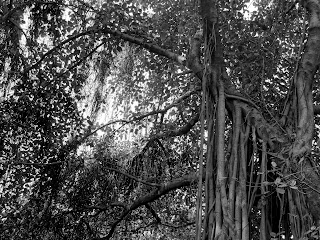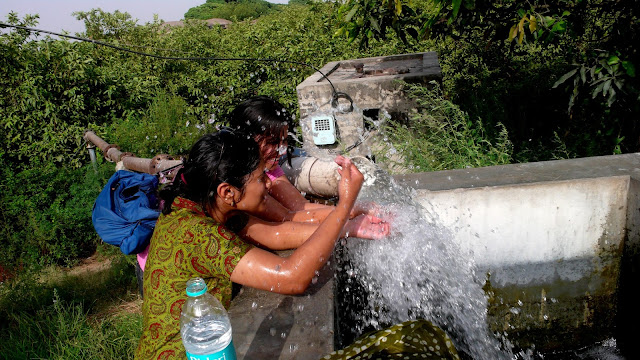Day 03: From Rajgarh to Hansali
Woh Bargad ka Paed : A 100 year old
banyan tree
Date: 2nd June, 2012,
Saturday
Location: Settlement Sarai Banjaran,
District: Patiala, Punjab
As we neared the Baradari and the historic tank of Sarai Banjaran located at a distance from the main settlement houses, we also passed by a small stretch of dense green patch with thick foliage. (Baradari also Bara Dari (Urdu: بارہ دری) is a building or pavilion with 12 doors designed to allow free flow of air.[1] The structure has three doorways on every side of the square shaped structure. Bara in Urdu/Hindi means Twelve and Dar is door. Courtesy: www.wikipedia.org.)
On our way back, our car was made to take us to the forested patch, and it so happened that this wasn’t a patch of trees. It was One tree. Singular! This Banyan tree was over a hundred years old and had a small village Mandir next to it. The branches of the Banyan had evidently just outgrown the mother tree so far off that the viral growth spread across the surroundings to form a dense cluster.
 |
| Baradari of Sarai Banjaran, Sarai Banjaran, Punjab |
 |
| The team for the trip venturing into the tree cluster |
 |
| Inside the wilderness |
On our way back, our car was made to take us to the forested patch, and it so happened that this wasn’t a patch of trees. It was One tree. Singular! This Banyan tree was over a hundred years old and had a small village Mandir next to it. The branches of the Banyan had evidently just outgrown the mother tree so far off that the viral growth spread across the surroundings to form a dense cluster.
 |
| Photos by Author |
The biodiversity of the place is quite varied as well. The patch happens to be a little humid as very little wind/breeze passes through the dense trees/branches. But the place is full of peacocks, owls, large spiders, and god knows what else.
 |
| Aerial roots of the Banyan |
 |
| Cobwebs |
I got the owl and the spider cobwebs.
As we walked out of that habitat, we were animatedly discussing how unexplored this mini-jungle was, one would just chance upon it and how it could be observed to get a glimpse into the biodiversity of the region, and maybe even examine the other flora - herbs and shrubs that were growing alongside the tree. Who knew what else would reveal itself?
Months later I find myself at Baroda (Vadodara) and I see myself
observing more and more of such old trees - Banyan to be precise. There is one right next to the
department of Sanskrit at the M.S. University that would least be a half a
century old. The tree is again a Banyan. There are a few really old trees a the
E.M.E. Temple in Baroda Cantt. The trees in the EME temple even have a story to
them. There is one right at the entrance to my office/apartment building and thats where I see my favorite family of seven squirrels.
But Baroda is a different chapter. Read on for more...



.JPG)
.JPG)

.jpg)



.jpg)










.JPG)
.JPG)

.JPG)






.JPG)
.JPG)





